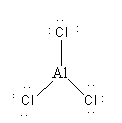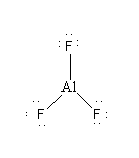
Which of the following molecules is not hypovalent?
A. ${\text{AlC}}{{\text{l}}_{\text{3}}}$
B. ${\text{AlB}}{{\text{r}}_{\text{3}}}$
C. ${\text{Al}}{{\text{F}}_{\text{3}}}$
D. All are hypovalent Because ${\text{Al}}{{\text{F}}_{\text{3}}}$ is an ionic compound
Answer
220.8k+ views
Hint: The molecules in which the central atom has less than 8 valence electrons are known as hypovalent molecules. Central atom hypovalent molecules do not obey the octet rule. The number of electrons in the valence shell of the central atom also depends on the type of bonding.
Complete step by step answer:
Determine the type of bond present in given compounds as follows:
In given compounds, central atom (${\text{Al}}$) is common only there is a change in bonding atom. Atoms ${\text{F}}$,${\text{Cl}}$and ${\text{Br}}$ are all halogens and present in the same group of the periodic table.
Atomic size of elements increases as we move from top to bottom in the periodic table. So the increase in order of the atomic size of ${\text{F}}$,${\text{Cl}}$and ${\text{Br}}$ is as follows :
${\text{F < Cl < Br}}$
Similarly, the order of the ionic size of ${{\text{F}}^{\text{ - }}}$,\[{\text{C}}{{\text{l}}^{\text{ - }}}\]and ${\text{B}}{{\text{r}}^{\text{ - }}}$ is as follows :
\[{{\text{F}}^{\text{ - }}}{\text{ < C}}{{\text{l}}^{\text{ - }}}{\text{ < B}}{{\text{r}}^{\text{ - }}}\]
The electronegativity of elements decreases as we move from top to bottom in the periodic table. So the decrease in order of electronegativity of ${\text{F}}$,${\text{Cl}}$and ${\text{Br}}$ is as follows:
${\text{F > Cl > Br}}$
In the case of compounds ${\text{Al}}{{\text{F}}_{\text{3}}}$,${\text{AlC}}{{\text{l}}_{\text{3}}}$and ${\text{AlB}}{{\text{r}}_{\text{3}}}$ cation (${\text{A}}{{\text{l}}^{{\text{3 + }}}}$) is common so an increase in the size of anion increases the covalent character of compounds. Due to the greater size of anions \[{\text{C}}{{\text{l}}^{\text{ - }}}\]and ${\text{B}}{{\text{r}}^{\text{ - }}}$ compounds ${\text{AlC}}{{\text{l}}_{\text{3}}}$and ${\text{AlB}}{{\text{r}}_{\text{3}}}$ are covalent compounds while due to greater electronegativity and smaller size of ${{\text{F}}^{\text{ - }}}$ ion compound${\text{Al}}{{\text{F}}_{\text{3}}}$ is an ionic compound.
Using the type of bond present determines the number of electrons in the valence shell of the central atom for all given compounds.
Atomic number of ${\text{Al}}$ is 13
So, the electronic configuration of a neutral ${\text{Al}}$ atom is 2, 8, 3

${\text{AlC}}{{\text{l}}_{\text{3}}}$ is a covalent compound so during covalent bond formation central ${\text{Al}}$ atom shares its 3 valence electrons with three ${\text{Cl}}$ atoms. As the central atom has less than 8 electrons so ${\text{AlC}}{{\text{l}}_{\text{3}}}$ is hypovalent compound.
So, option (A) ${\text{AlC}}{{\text{l}}_{\text{3}}}$ is not the correct option.
${\text{AlB}}{{\text{r}}_{\text{3}}}$ is a covalent compound so during covalent bond formation central ${\text{Al}}$ atom shares its 3 valence electrons with three ${\text{Br}}$ atoms. As the central atom has less than 8 electrons so ${\text{AlB}}{{\text{r}}_{\text{3}}}$ is hypovalent compound.

So, option (B) ${\text{AlB}}{{\text{r}}_{\text{3}}}$ is not the correct option.

${\text{Al}}{{\text{F}}_{\text{3}}}$ is an ionic compound so during ionic bond formation central ${\text{Al}}$ atom donates its outermost 3 electrons. So, ${\text{A}}{{\text{l}}^{{\text{3 + }}}}$ ion in ${\text{Al}}{{\text{F}}_{\text{3}}}$ has electronic configuration 2, 8. As the octet of the central atom is fulfilled so ${\text{Al}}{{\text{F}}_{\text{3}}}$ is not hypovalent compound.
Thus, the correct option is C.
Note:Though in all compounds${\text{Al}}{{\text{F}}_{\text{3}}}$,${\text{AlC}}{{\text{l}}_{\text{3}}}$and ${\text{AlB}}{{\text{r}}_{\text{3}}}$there is a bond between the metal and non-metal only ${\text{Al}}{{\text{F}}_{\text{3}}}$ is ionic compound while ${\text{AlC}}{{\text{l}}_{\text{3}}}$and ${\text{AlB}}{{\text{r}}_{\text{3}}}$ are covalent compounds
Complete step by step answer:
Determine the type of bond present in given compounds as follows:
In given compounds, central atom (${\text{Al}}$) is common only there is a change in bonding atom. Atoms ${\text{F}}$,${\text{Cl}}$and ${\text{Br}}$ are all halogens and present in the same group of the periodic table.
Atomic size of elements increases as we move from top to bottom in the periodic table. So the increase in order of the atomic size of ${\text{F}}$,${\text{Cl}}$and ${\text{Br}}$ is as follows :
${\text{F < Cl < Br}}$
Similarly, the order of the ionic size of ${{\text{F}}^{\text{ - }}}$,\[{\text{C}}{{\text{l}}^{\text{ - }}}\]and ${\text{B}}{{\text{r}}^{\text{ - }}}$ is as follows :
\[{{\text{F}}^{\text{ - }}}{\text{ < C}}{{\text{l}}^{\text{ - }}}{\text{ < B}}{{\text{r}}^{\text{ - }}}\]
The electronegativity of elements decreases as we move from top to bottom in the periodic table. So the decrease in order of electronegativity of ${\text{F}}$,${\text{Cl}}$and ${\text{Br}}$ is as follows:
${\text{F > Cl > Br}}$
In the case of compounds ${\text{Al}}{{\text{F}}_{\text{3}}}$,${\text{AlC}}{{\text{l}}_{\text{3}}}$and ${\text{AlB}}{{\text{r}}_{\text{3}}}$ cation (${\text{A}}{{\text{l}}^{{\text{3 + }}}}$) is common so an increase in the size of anion increases the covalent character of compounds. Due to the greater size of anions \[{\text{C}}{{\text{l}}^{\text{ - }}}\]and ${\text{B}}{{\text{r}}^{\text{ - }}}$ compounds ${\text{AlC}}{{\text{l}}_{\text{3}}}$and ${\text{AlB}}{{\text{r}}_{\text{3}}}$ are covalent compounds while due to greater electronegativity and smaller size of ${{\text{F}}^{\text{ - }}}$ ion compound${\text{Al}}{{\text{F}}_{\text{3}}}$ is an ionic compound.
Using the type of bond present determines the number of electrons in the valence shell of the central atom for all given compounds.
Atomic number of ${\text{Al}}$ is 13
So, the electronic configuration of a neutral ${\text{Al}}$ atom is 2, 8, 3

${\text{AlC}}{{\text{l}}_{\text{3}}}$ is a covalent compound so during covalent bond formation central ${\text{Al}}$ atom shares its 3 valence electrons with three ${\text{Cl}}$ atoms. As the central atom has less than 8 electrons so ${\text{AlC}}{{\text{l}}_{\text{3}}}$ is hypovalent compound.
So, option (A) ${\text{AlC}}{{\text{l}}_{\text{3}}}$ is not the correct option.
${\text{AlB}}{{\text{r}}_{\text{3}}}$ is a covalent compound so during covalent bond formation central ${\text{Al}}$ atom shares its 3 valence electrons with three ${\text{Br}}$ atoms. As the central atom has less than 8 electrons so ${\text{AlB}}{{\text{r}}_{\text{3}}}$ is hypovalent compound.

So, option (B) ${\text{AlB}}{{\text{r}}_{\text{3}}}$ is not the correct option.

${\text{Al}}{{\text{F}}_{\text{3}}}$ is an ionic compound so during ionic bond formation central ${\text{Al}}$ atom donates its outermost 3 electrons. So, ${\text{A}}{{\text{l}}^{{\text{3 + }}}}$ ion in ${\text{Al}}{{\text{F}}_{\text{3}}}$ has electronic configuration 2, 8. As the octet of the central atom is fulfilled so ${\text{Al}}{{\text{F}}_{\text{3}}}$ is not hypovalent compound.
Thus, the correct option is C.
Note:Though in all compounds${\text{Al}}{{\text{F}}_{\text{3}}}$,${\text{AlC}}{{\text{l}}_{\text{3}}}$and ${\text{AlB}}{{\text{r}}_{\text{3}}}$there is a bond between the metal and non-metal only ${\text{Al}}{{\text{F}}_{\text{3}}}$ is ionic compound while ${\text{AlC}}{{\text{l}}_{\text{3}}}$and ${\text{AlB}}{{\text{r}}_{\text{3}}}$ are covalent compounds
Recently Updated Pages
The hybridization and shape of NH2 ion are a sp2 and class 11 chemistry JEE_Main

What is the pH of 001 M solution of HCl a 1 b 10 c class 11 chemistry JEE_Main

Aromatization of nhexane gives A Benzene B Toluene class 11 chemistry JEE_Main

Show how you will synthesise i 1Phenylethanol from class 11 chemistry JEE_Main

The enolic form of acetone contains a 10sigma bonds class 11 chemistry JEE_Main

Which of the following Compounds does not exhibit tautomerism class 11 chemistry JEE_Main

Trending doubts
Understanding Atomic Structure for Beginners

Understanding Entropy Changes in Different Processes

Common Ion Effect: Concept, Applications, and Problem-Solving

What Are Elastic Collisions in One Dimension?

Free Radical Substitution and Its Stepwise Mechanism

Understanding Geostationary and Geosynchronous Satellites

Other Pages
JEE Advanced 2026 Revision Notes for Practical Organic Chemistry

NCERT Solutions For Class 11 Chemistry Chapter 7 Equilibrium in Hindi - 2025-26

Understanding Centrifugal Force in Physics

JEE Main Marking Scheme 2026- Paper-Wise Marks Distribution and Negative Marking Details

Devuthani Ekadashi 2025: Correct Date, Shubh Muhurat, Parana Time & Puja Vidhi

Difference Between Exothermic and Endothermic Reactions: Key Differences, Examples & Diagrams




